technical specifications Alfa Romeo Giulietta 2011 Owner handbook (in English)
[x] Cancel search | Manufacturer: ALFA ROMEO, Model Year: 2011, Model line: Giulietta, Model: Alfa Romeo Giulietta 2011Pages: 297, PDF Size: 9.37 MB
Page 209 of 297
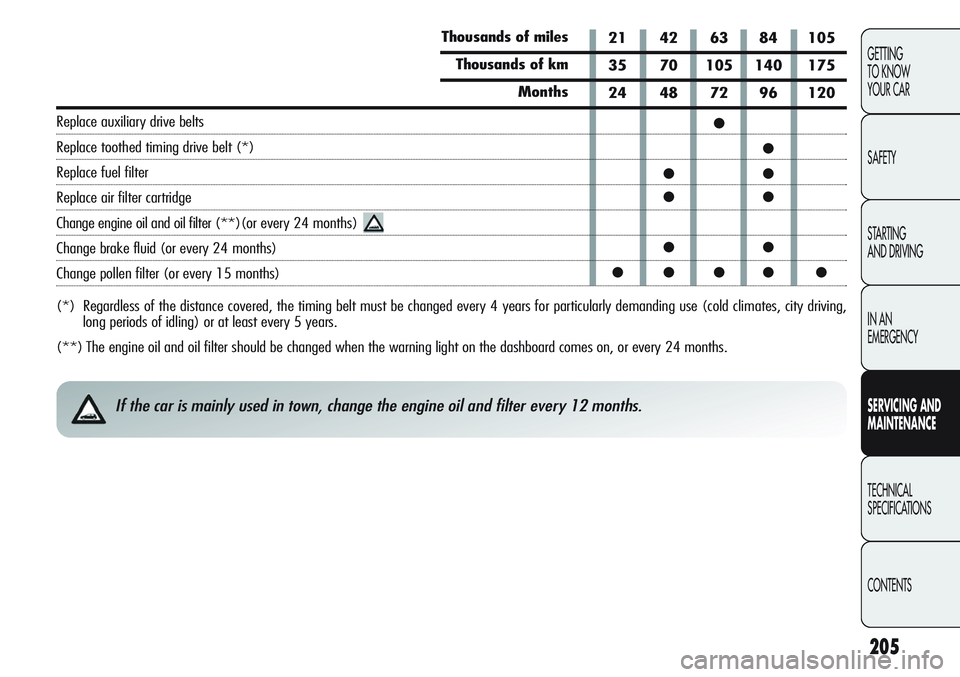
205
GETTING
TO KNOW
YOUR CAR
SAFETY
STARTING
AND DRIVING
IN AN
EMERGENCY
SERVICING AND
MAINTENANCE
TECHNICAL
SPECIFICATIONS
CONTENTS
21 42 63 84 105
35 70 105 140 175
24 48 72 96 120
●
●
●●
●●
●●
●●●● ●
Thousands of miles
Thousands of km
Months
Replace auxiliary drive belts
Replace toothed timing drive belt (*)
Replace fuel filter
Replace air filter cartridge
Change engine oil and oil filter (**)(or every 24 months)
Change brake fluid (or every 24 months)
Change pollen filter (or every 15 months)
(*) Regardless of the distance covered, the timing belt must be changed every 4 years for particularly demanding use (cold climates, city driving,
long periods of idling) or at least every 5 years.
(**) The engine oil and oil filter should be changed when the warning light on the dashboard comes on, or every 24 months.
If the car is mainly used in town, change the engine oil and filter every 12 months.
Page 210 of 297
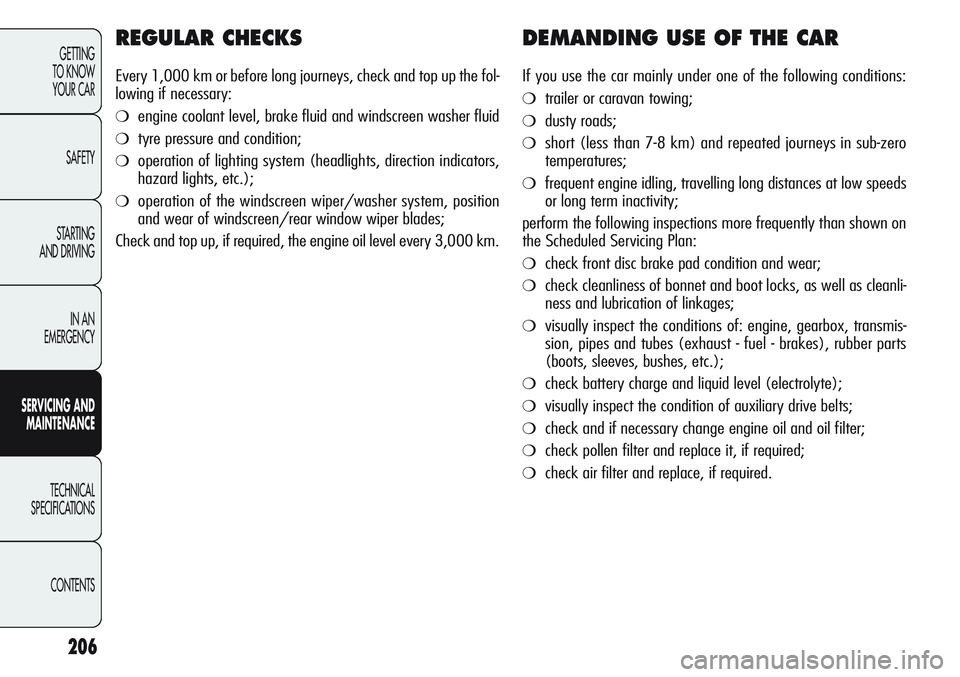
206
GETTING
TO KNOW
YOUR CAR
SAFETY
STARTING
AND DRIVING
IN AN
EMERGENCY
SERVICING AND
MAINTENANCE
TECHNICAL
SPECIFICATIONS
CONTENTS
REGULAR CHECKS
Every 1,000 km or before long journeys, check and top up the fol-
lowing if necessary:
❍engine coolant level, brake fluid and windscreen washer fluid
❍tyre pressure and condition;
❍operation of lighting system (headlights, direction indicators,
hazard lights, etc.);
❍operation of the windscreen wiper/washer system, position
and wear of windscreen/rear window wiper blades;
Check and top up, if required, the engine oil level every 3,000 km.
DEMANDING USE OF THE CAR
If you use the car mainly under one of the following conditions:
❍trailer or caravan towing;
❍dusty roads;
❍short (less than 7-8 km) and repeated journeys in sub-zero
temperatures;
❍frequent engine idling, travelling long distances at low speeds
or long term inactivity;
perform the following inspections more frequently than shown on
the Scheduled Servicing Plan:
❍check front disc brake pad condition and wear;
❍check cleanliness of bonnet and boot locks, as well as cleanli-
ness and lubrication of linkages;
❍visually inspect the conditions of: engine, gearbox, transmis-
sion, pipes and tubes (exhaust - fuel - brakes), rubber parts
(boots, sleeves, bushes, etc.);
❍check battery charge and liquid level (electrolyte);
❍visually inspect the condition of auxiliary drive belts;
❍check and if necessary change engine oil and oil filter;
❍check pollen filter and replace it, if required;
❍check air filter and replace, if required.
Page 211 of 297
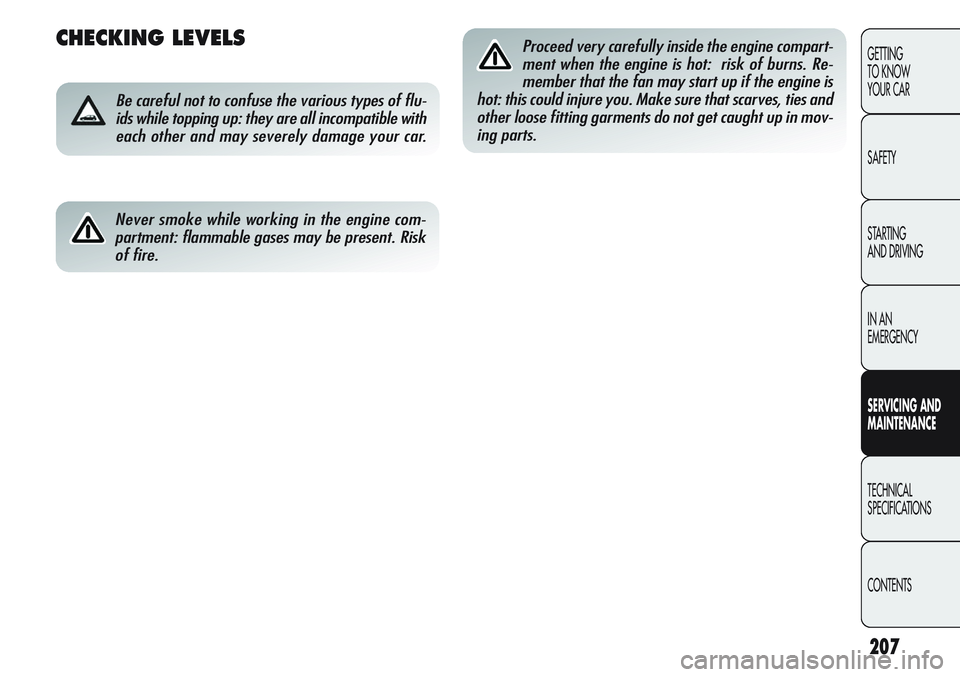
207
GETTING
TO KNOW
YOUR CAR
SAFETY
STARTING
AND DRIVING
IN AN
EMERGENCY
SERVICING AND
MAINTENANCE
TECHNICAL
SPECIFICATIONS
CONTENTS
CHECKING LEVELS
Be careful not to confuse the various types of flu-
ids while topping up: they are all incompatible with
each other and may severely damage your car.
Never smoke while working in the engine com-
partment: flammable gases may be present. Risk
of fire.
Proceed very carefully inside the engine compart-
ment when the engine is hot: risk of burns. Re-
member that the fan may start up if the engine is
hot: this could injure you. Make sure that scarves, ties and
other loose fitting garments do not get caught up in mov-
ing parts.
Page 212 of 297
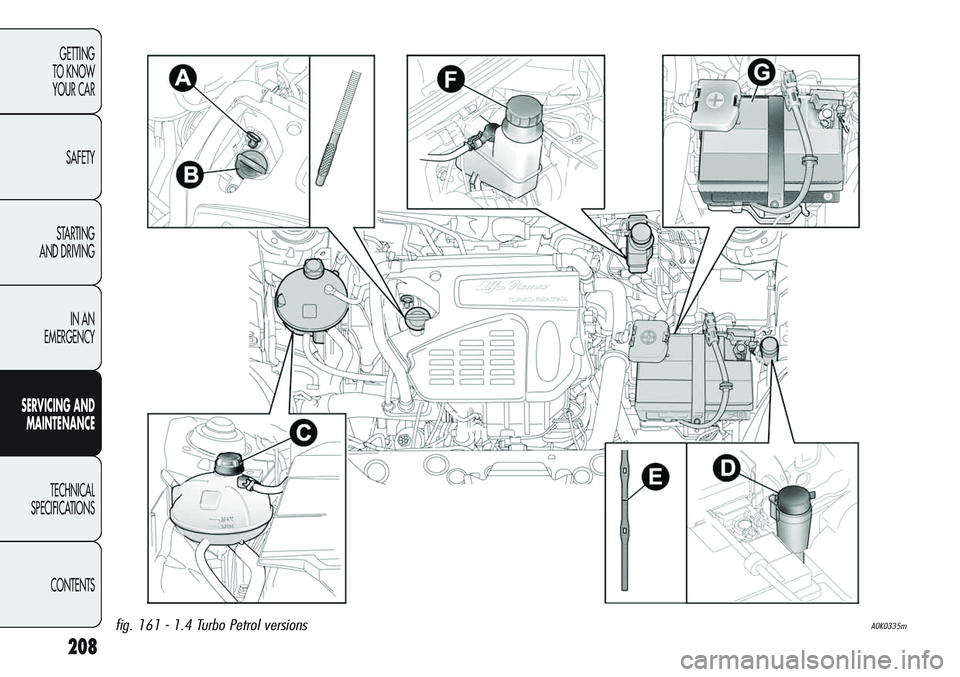
208
GETTING
TO KNOW
YOUR CAR
SAFETY
STARTING
AND DRIVING
IN AN
EMERGENCY
SERVICING AND
MAINTENANCE
TECHNICAL
SPECIFICATIONS
CONTENTS
fig. 161 - 1.4 Turbo Petrol versionsA0K0335m
Page 213 of 297
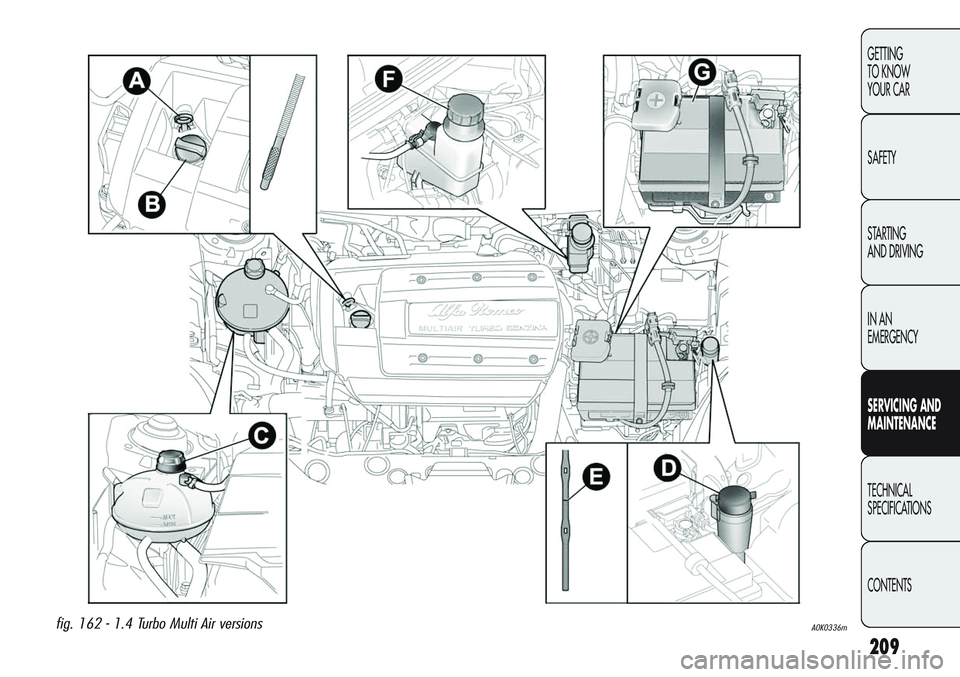
209
GETTING
TO KNOW
YOUR CAR
SAFETY
STARTING
AND DRIVING
IN AN
EMERGENCY
SERVICING AND
MAINTENANCE
TECHNICAL
SPECIFICATIONS
CONTENTS
fig. 162 - 1.4 Turbo Multi Air versionsA0K0336m
Page 214 of 297
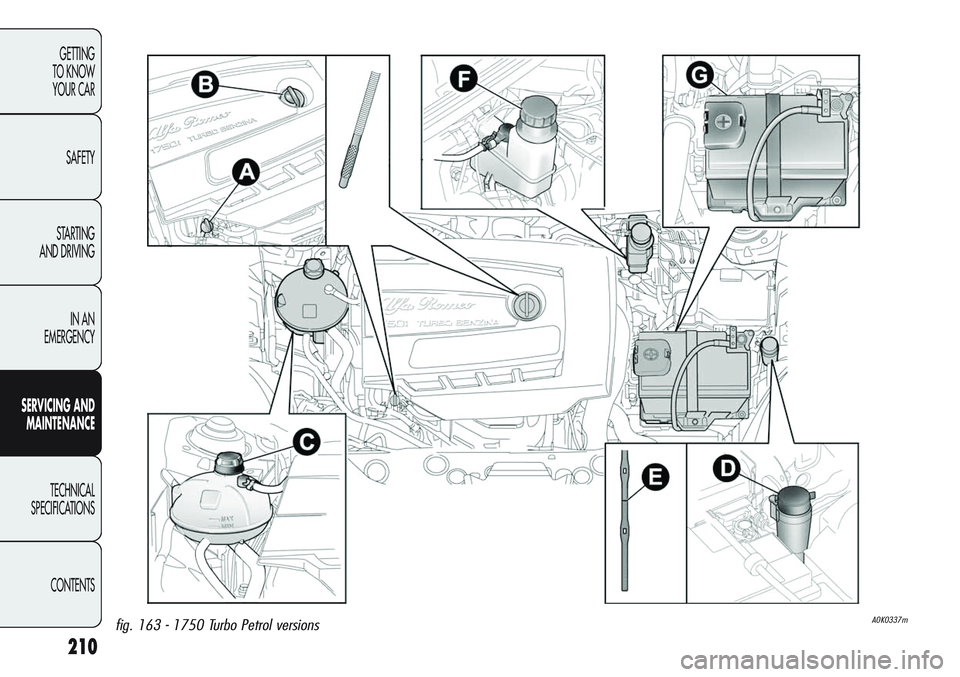
210
GETTING
TO KNOW
YOUR CAR
SAFETY
STARTING
AND DRIVING
IN AN
EMERGENCY
SERVICING AND
MAINTENANCE
TECHNICAL
SPECIFICATIONS
CONTENTS
fig. 163 - 1750 Turbo Petrol versionsA0K0337m
Page 215 of 297
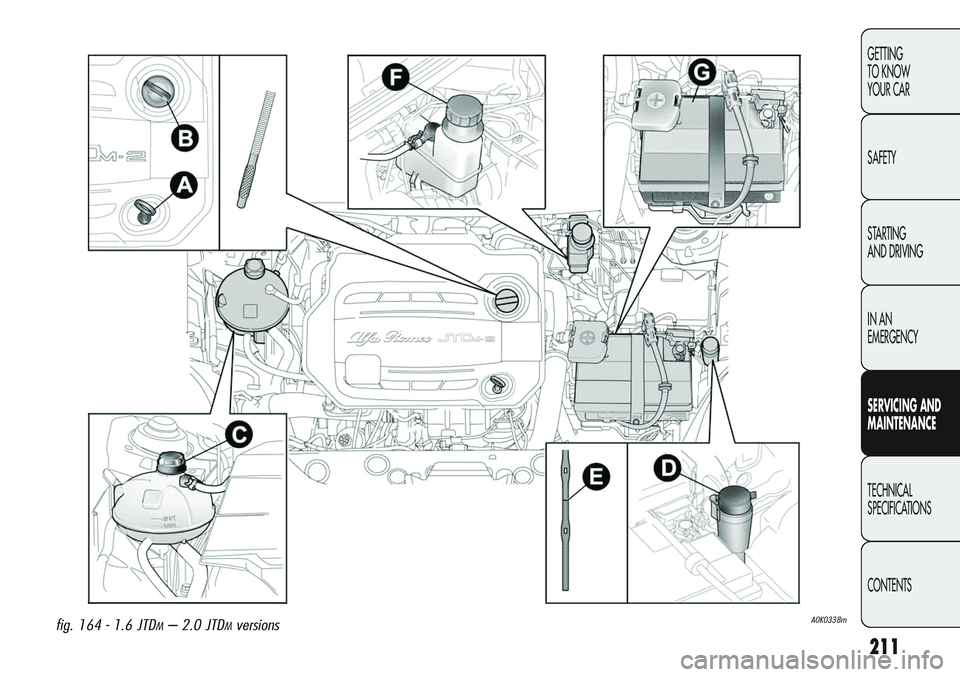
211
GETTING
TO KNOW
YOUR CAR
SAFETY
STARTING
AND DRIVING
IN AN
EMERGENCY
SERVICING AND
MAINTENANCE
TECHNICAL
SPECIFICATIONS
CONTENTS
fig. 164 - 1.6 JTDM– 2.0 JTDMversionsA0K0338m
Page 216 of 297
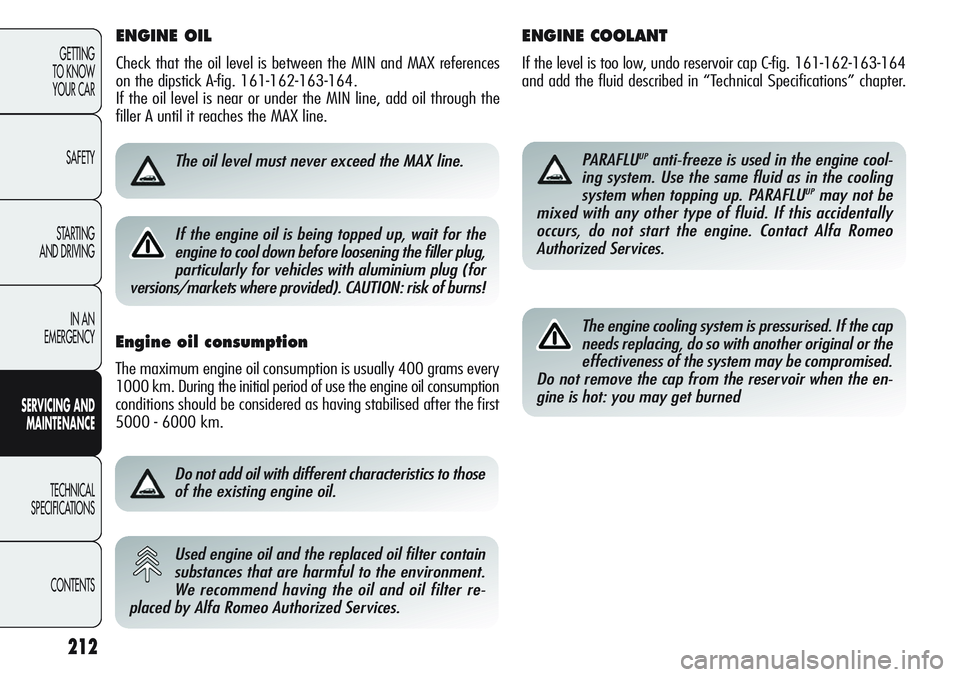
ENGINE OIL
Check that the oil level is between the MIN and MAX references
on the dipstick A-fig. 161-162-163-164.
If the oil level is near or under the MIN line, add oil through the
filler A until it reaches the MAX line.
Do not add oil with different characteristics to those
of the existing engine oil.
Used engine oil and the replaced oil filter contain
substances that are harmful to the environment.
We recommend having the oil and oil filter re-
placed by Alfa Romeo Authorized Services.
ENGINE COOLANT
If the level is too low, undo reservoir cap C-fig. 161-162-163-164
and add the fluid described in “Technical Specifications” chapter.
PARAFLUUPanti-freeze is used in the engine cool-
ing system. Use the same fluid as in the cooling
system when topping up. PARAFLU
UPmay not be
mixed with any other type of fluid. If this accidentally
occurs, do not start the engine. Contact Alfa Romeo
Authorized Services.
The engine cooling system is pressurised. If the cap
needs replacing, do so with another original or the
effectiveness of the system may be compromised.
Do not remove the cap from the reservoir when the en-
gine is hot: you may get burned
212
GETTING
TO KNOW
YOUR CAR
SAFETY
STARTING
AND DRIVING
IN AN
EMERGENCY
SERVICING AND
MAINTENANCE
TECHNICAL
SPECIFICATIONS
CONTENTS
The oil level must never exceed the MAX line.
Engine oil consumption
The maximum engine oil consumption is usually 400 grams every
1000 km. During the initial period of use the engine oil consumption
conditions should be considered as having stabilised after the first
5000 - 6000 km.
If the engine oil is being topped up, wait for the
engine to cool down before loosening the filler plug,
particularly for vehicles with aluminium plug (for
versions/markets where provided). CAUTION: risk of burns!
Page 217 of 297
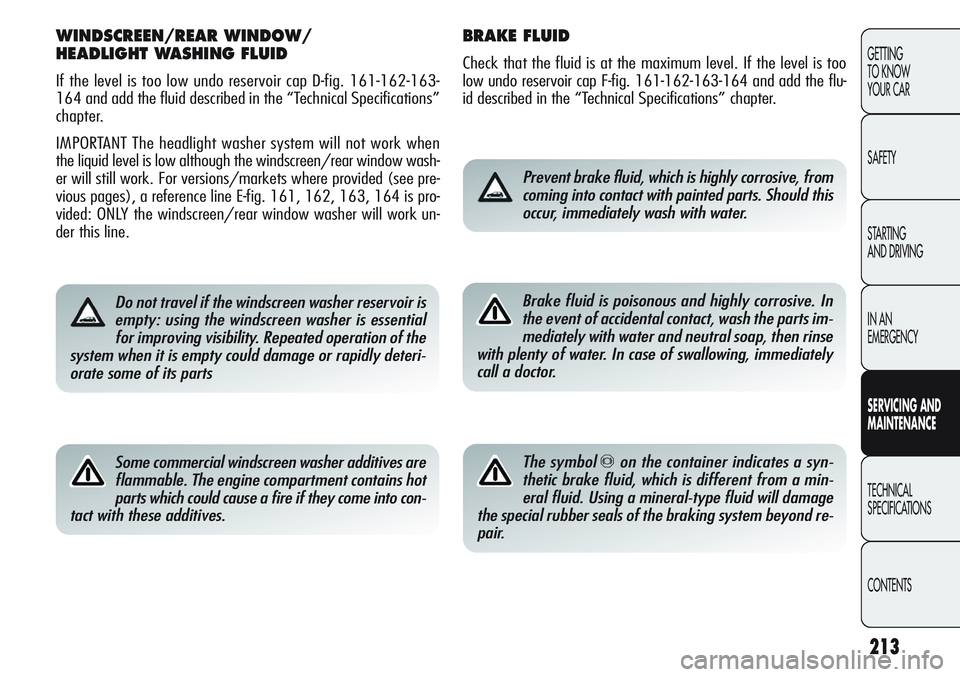
213
GETTING
TO KNOW
YOUR CAR
SAFETY
STARTING
AND DRIVING
IN AN
EMERGENCY
SERVICING AND
MAINTENANCE
TECHNICAL
SPECIFICATIONS
CONTENTS
BRAKE FLUID
Check that the fluid is at the maximum level. If the level is too
low undo reservoir cap F-fig. 161-162-163-164 and add the flu-
id described in the “Technical Specifications” chapter.
Prevent brake fluid, which is highly corrosive, from
coming into contact with painted parts. Should this
occur, immediately wash with water.
WINDSCREEN/REAR WINDOW/
HEADLIGHT WASHING FLUID
If the level is too low undo reservoir cap D-fig. 161-162-163-
164 and add the fluid described in the “Technical Specifications”
chapter.
IMPORTANT The headlight washer system will not work when
the liquid level is low although the windscreen/rear window wash-
er will still work. For versions/markets where provided (see pre-
vious pages), a reference line E-fig. 161, 162, 163, 164 is pro-
vided: ONLY the windscreen/rear window washer will work un-
der this line.
Some commercial windscreen washer additives are
flammable. The engine compartment contains hot
parts which could cause a fire if they come into con-
tact with these additives.
Brake fluid is poisonous and highly corrosive. In
the event of accidental contact, wash the parts im-
mediately with water and neutral soap, then rinse
with plenty of water. In case of swallowing, immediately
call a doctor.
The symbol πon the container indicates a syn-
thetic brake fluid, which is different from a min-
eral fluid. Using a mineral-type fluid will damage
the special rubber seals of the braking system beyond re-
pair.
Do not travel if the windscreen washer reservoir is
empty: using the windscreen washer is essential
for improving visibility. Repeated operation of the
system when it is empty could damage or rapidly deteri-
orate some of its parts
Page 218 of 297
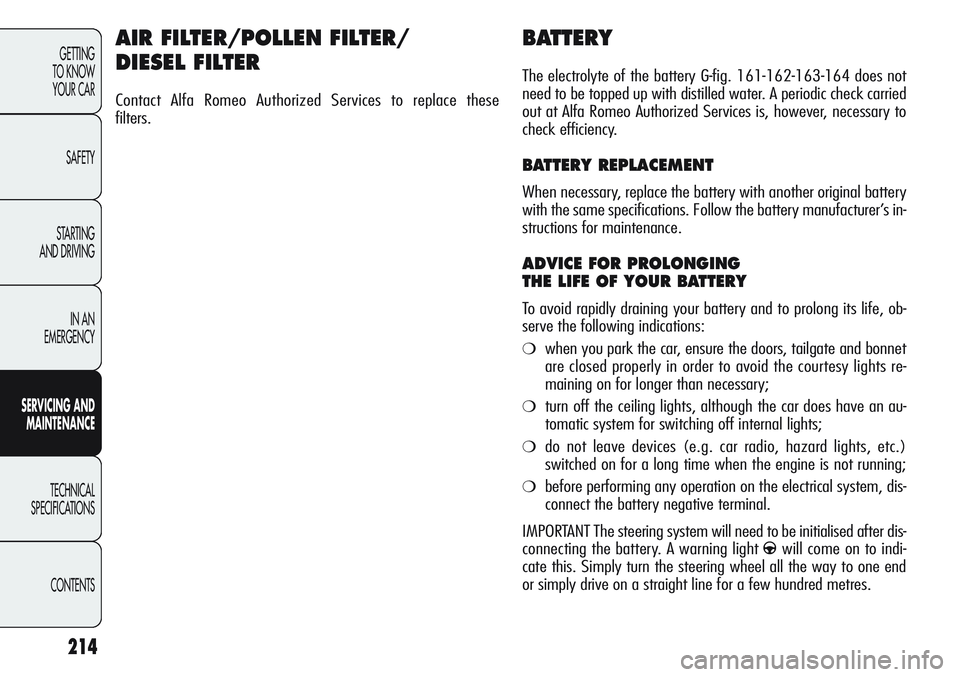
214
GETTING
TO KNOW
YOUR CAR
SAFETY
STARTING
AND DRIVING
IN AN
EMERGENCY
SERVICING AND
MAINTENANCE
TECHNICAL
SPECIFICATIONS
CONTENTS
BATTERY
The electrolyte of the battery G-fig. 161-162-163-164 does not
need to be topped up with distilled water. A periodic check carried
out at Alfa Romeo Authorized Services is, however, necessary to
check efficiency.
BATTERY REPLACEMENT
When necessary, replace the battery with another original battery
with the same specifications. Follow the battery manufacturer’s in-
structions for maintenance.
ADVICE FOR PROLONGING
THE LIFE OF YOUR BATTERY
To avoid rapidly draining your battery and to prolong its life, ob-
serve the following indications:
❍when you park the car, ensure the doors, tailgate and bonnet
are closed properly in order to avoid the courtesy lights re-
maining on for longer than necessary;
❍turn off the ceiling lights, although the car does have an au-
tomatic system for switching off internal lights;
❍do not leave devices (e.g. car radio, hazard lights, etc.)
switched on for a long time when the engine is not running;
❍before performing any operation on the electrical system, dis-
connect the battery negative terminal.
IMPORTANT The steering system will need to be initialised after dis-
connecting the battery. A warning light
gwill come on to indi-
cate this. Simply turn the steering wheel all the way to one end
or simply drive on a straight line for a few hundred metres.
AIR FILTER/POLLEN FILTER/
DIESEL FILTER
Contact Alfa Romeo Authorized Services to replace these
filters.